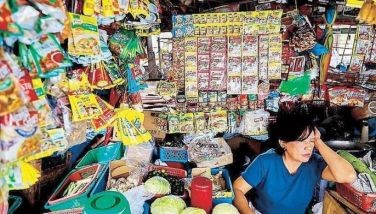Heroes and villains
It must be the masochist in me that makes me watch the early evening newscasts with their daily stories of dishonesty, extortion and mayhem at all levels of society. Eager job seekers are tricked into losing sizeable sums of money by people pretending to be recruiters. Young girls from the provinces looking for decent work are forced into prostitution.
In business and government, we often hear complaints from foreigners about how they have tried to play the game here by our corrupt rules and yet we fail to deliver. The biggest example often cited is NAIA 3. The Germans have “accommodated” three administrations but got nothing. Our officials do not stay bought… Filipino officials just keep on going after a higher bid.
Sometimes, all these stories can lead one to despair about life in our islands and the lack of character of today’s Filipino. But despair not. Dishonesty is not a racial trait imbedded in our DNA. Carmen Guerrero Nakpil reassures us in her latest book, Heroes and Villains that Filipinos, or at least the people who inhabited these islands before the Spaniards came, are by nature honest.
According to Ms. Nakpil, historical records show “that Chinese traders visited Ma-I (Luzon) regularly, leaving silks, porcelain and metal utensils on the beaches of designated islands, and returning weeks later to collect payment in the form of beeswax, gold dust, carabao horn, ginger, cinnamon or garlic. An honor system with unquestioned good faith.”
Indeed, if there is anything that reading Ms. Nakpil’s latest book will do for today’s Filipino, it is to make him feel good about the nobility of his people. Unfortunately, the last 400 years or so of Spanish, American and Japanese subjugation not only brought the worse in us. The experience also inflicted a blow to our collective self respect for which only the balm of historical truth can offer relief.
Unfortunately, we have been taught the version of history from the perspective of our former foreign colonial masters. It is as if they never left. I particularly blame the Catholic schools whose version of history leaves us thinking that we moved out of the dark ages only after Magellan “discovered” our islands.
P-Noy must have read the same history book used in a Catholic school I attended or he wouldn’t have made that mistake of thinking the blood compact was about friendship in a speech during his recent US visit. It is actually another instance of colonial subjugation that no Filipino should be proud of.
The version of history taught in Catholic schools of my time paints us in the way US President McKinley thought of us: a savage people needy of salvation from the white man. Nothing can be further from the truth, as Ms. Nakpil points out in Heroes and Villains. “One has to only read Mabini, Jacinto, Bonifacio, Luna who were certainly the intellectual and moral superiors of Americans like McKinley and Taft.”
Ms. Nakpil also cites Harvard historian Laurence Bergreen who observe that “Filipinos had long been literate when Magellan came.” The Filipinos at that time were more used to visits of the Chinese treasure fleet for they have been trading with China for over 500 years before Magellan.
Filipinos had never seen white men before Magellan, Ms. Nakpil relates, and never thought the strangers would be as rapacious and predatory as they would prove to be. “The Chinese, on the other hand, were not interested in conquest or territorial aggrandizement. Their purposes were trade and diplomacy. That was what our ancestors expected when they saw the Spanish armada…”
One other historical falsehood we were taught is about Magellan or his successor after his death at Mactan being the first to circumnavigate the world. In fact, the first man to do just that could well be a Filipino, a Visayan who was captured by pirates probably from Samar, bought by Magellan in a slave market in Malacca and returned in 1521 when Magellan supposedly discovered the Philippines. Ms. Nakpil calls him the first OFW and devoted a chapter to him in the book.
There is an entire chapter on Corruption in Ancient Manila, a very informative historical review of a very contemporary scourge. The Galleon trade was the backdrop of corruption in colonial Manila. Spanish officials became rich by simply turning a blind eye to the official ban on other nationalities (English, Dutch, French) participating in the trade.
Eventually, the corruption contaminated the native elite. “That weakness in the national character is described by Dr. Quiason thus: ‘The indios Filipinos developed a special preference for the imported fabrics of bright colors (hand-woven chintz, muslin, calico, gingham, taffeta), specially the womenfolk who made them into exquisite saya and tapis worn by the affluent indio women. The importing craze whetted the appetite for diamonds and precious stones brought by Armenian merchants.’”
Ms. Nakpil also related an interesting sidebar story to the illegal trade. This is the participation of a Welshman born and raised in America named Elihu Yale. Yes, he is the same Yale who “made mammoth donation to an obscure college in ‘Conecticot’ which became one of the pillars of US Ivy League and bore his name…” Yale moved to India and “became one of the richest merchants trading in diamonds, slaves, money-lending, spices shipping and other contraband enterprises in Manila and Maguindanao.”
In bringing up corruption in 17th century Manila, is Ms. Nakpil is saying “that corruption is endemic to our country, like malaria or dengue fever because there’s nothing we can do about the behavior of mosquitoes?”
Not so fast. She reminds us of how the Chinese chronicles recorded the honesty of our forefathers… “Our real heritage is the honor system.” Ms. Nakpil also picks up from our national hero: “Rizal said that even our defects are those of our colonizers.” For Ms. Nakpil, “during those long oppressive centuries, we Filipinos were carefully taught by example; from Spain, sloth and braggadocio; from America, materialism and hypocrisy; and from both, that corruption was a tool for survival.
Ms. Nakpil says we need to bury the dead horse of colonization, with its deadly effects on our subconscious and expunge the poisonous habits that its carcass infected us with. Otherwise, “we shall remain in the shame list of the world’s most corrupt countries.”
But the Spaniards left us something worth emulating. This is the Residencia. It is the system by which the outgoing Spanish Governor General is made to account for his watch. He has to answer charges and complaints brought on by the King’s subjects and submit to a panel of judges led by his successor.
It now seems that P-Noy’s Truth Commission has a historical basis. The Residencia makes sure penalties are imposed for any transgressions, including confiscation, restitution or even jail terms. So why didn’t we have this system when we have copied almost every thing else, particularly the vices?
Ms. Nakpil’s view: The fault, dear fellow Pinoys, lies in that we chose to copy the many vices of our colonizers but none of their few virtues. We gladly took up their self indulgence, but very little of their discipline. We inherited the Siesta, the Fiesta and the Compadre (kumpare) and Spangalog (almost half of the nouns in our national language are Spanish words) but not the rational, sensible institutions like the Residencia.”
Oh well… I don’t have space to share many other insights of Ms. Nakpil that should shock today’s historically-challenged Pinoy. Now 88 years old, Ms. Nakpil has not lost her ability to use language as a sharp knife cutting through the pretensions of society that are at the root of our malaise. A Filipino who truly loves his country should start looking at history from a fresh and independent perspective. Reading this book is an entertaining and very educational first step.
I want to share the words of columnist Tony Abaya who once wrote of Ms. Nakpil: “Carmen Guerrero Nakpil is one of the heroines in the small pantheon where I worship whose impeccable prose, gentled good sense, and wry humor often made the unbearable bearable in this our most imperfect Inang Bayan.” My sentiments exactly!
The book Heroes and Villains is being launched this evening from 5 to 7 p.m. at the Philippines Heritage Library, Nielson Tower in Makati. See you there.
Crab mentality
Here’s another take on crab mentality I borrowed from my colleague Wilson Lee Flores.
Many of our politicians and government bureaucrats think this way—Three guys, stranded on a desert island, find a magic lantern containing a genie, who grants them each one wish.
The first guy wishes he was off the island and back home. The second guy wishes the same. The third guy says “I’m lonely. I wish my friends were back here.”
Boo Chanco’s e-mail address is [email protected]
- Latest
- Trending































